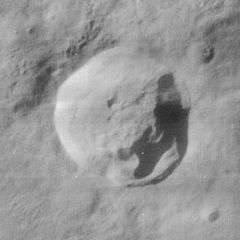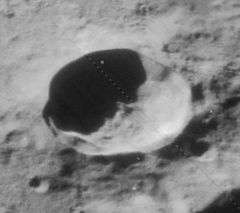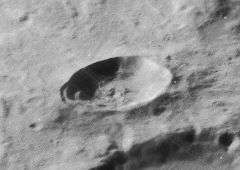Thales (crater)
Thales is a small crater located in the northeast part of the Moon, just to the west of the larger crater Strabo. To the southeast is the walled plain De La Rue. Thales has a sharp, circular rim that has received little erosion. The lunar surface around Thales has a ray system that extends for over 600 kilometers, and it is consequently mapped as part of the Copernican System.[1] . An area to the north-northwest of the crater is free of rays, however, indicating that the crater may have been formed by a low-angle impact from that direction. The inner wall has some terraces, particularly along the southern side. The sides have a higher albedo than the typical lunar terrain.
 Lunar Orbiter 4 image | |
| Coordinates | 61.8°N 50.3°E |
|---|---|
| Diameter | 32 km |
| Depth | 1.8 km |
| Colongitude | 314° at sunrise |
| Eponym | Thales |


This crater has been noted for transient lunar phenomena. In 1892, E. E. Barnard observed a pale haze fill the crater interior, while the surroundings remained clear and sharply visible.
Satellite craters
By convention these features are identified on lunar maps by placing the letter on the side of the crater midpoint that is closest to Thales.
| Thales | Latitude | Longitude | Diameter |
|---|---|---|---|
| A | 58.5° N | 40.8° E | 12 km |
| E | 57.2° N | 43.2° E | 29 km |
| F | 59.4° N | 42.1° E | 37 km |
| G | 61.6° N | 45.3° E | 12 km |
| H | 60.3° N | 48.0° E | 10 km |
| W | 58.5° N | 39.8° E | 6 km |
References
- The geologic history of the Moon, 1987, Wilhelms, Don E.; with sections by McCauley, John F.; Trask, Newell J. USGS Professional Paper: 1348. Plate 11: Copernican System (online)
- Andersson, L. E.; Whitaker, E. A. (1982). NASA Catalogue of Lunar Nomenclature. NASA RP-1097.CS1 maint: ref=harv (link)
- Blue, Jennifer (July 25, 2007). "Gazetteer of Planetary Nomenclature". USGS. Retrieved 2007-08-05.CS1 maint: ref=harv (link)
- Bussey, B.; Spudis, P. (2004). The Clementine Atlas of the Moon. New York: Cambridge University Press. ISBN 978-0-521-81528-4.CS1 maint: ref=harv (link)
- Cocks, Elijah E.; Cocks, Josiah C. (1995). Who's Who on the Moon: A Biographical Dictionary of Lunar Nomenclature. Tudor Publishers. ISBN 978-0-936389-27-1.CS1 maint: ref=harv (link)
- McDowell, Jonathan (July 15, 2007). "Lunar Nomenclature". Jonathan's Space Report. Retrieved 2007-10-24.CS1 maint: ref=harv (link)
- Menzel, D. H.; Minnaert, M.; Levin, B.; Dollfus, A.; Bell, B. (1971). "Report on Lunar Nomenclature by the Working Group of Commission 17 of the IAU". Space Science Reviews. 12 (2): 136–186. Bibcode:1971SSRv...12..136M. doi:10.1007/BF00171763.CS1 maint: ref=harv (link)
- Moore, Patrick (2001). On the Moon. Sterling Publishing Co. ISBN 978-0-304-35469-6.CS1 maint: ref=harv (link)
- Price, Fred W. (1988). The Moon Observer's Handbook. Cambridge University Press. ISBN 978-0-521-33500-3.CS1 maint: ref=harv (link)
- Rükl, Antonín (1990). Atlas of the Moon. Kalmbach Books. ISBN 978-0-913135-17-4.CS1 maint: ref=harv (link)
- Webb, Rev. T. W. (1962). Celestial Objects for Common Telescopes (6th revised ed.). Dover. ISBN 978-0-486-20917-3.CS1 maint: ref=harv (link)
- Whitaker, Ewen A. (1999). Mapping and Naming the Moon. Cambridge University Press. ISBN 978-0-521-62248-6.CS1 maint: ref=harv (link)
- Wlasuk, Peter T. (2000). Observing the Moon. Springer. ISBN 978-1-85233-193-1.CS1 maint: ref=harv (link)